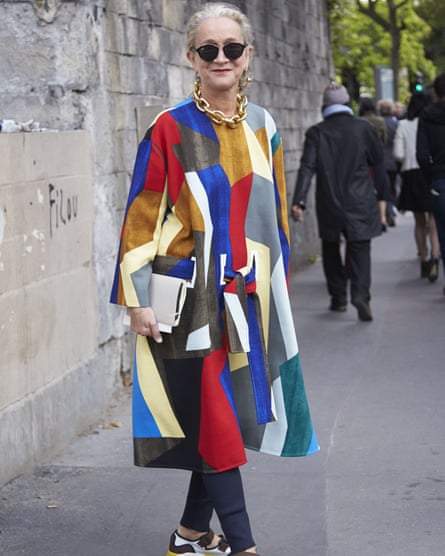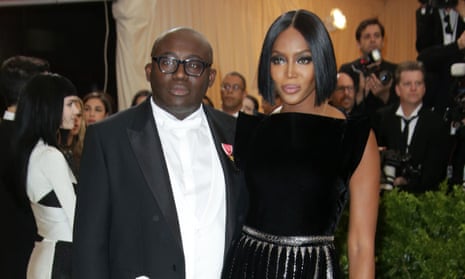For a new boss to dismiss the “old guard” who were the legacy of their predecessor and bring in new faces is not unusual. Indeed, when Alexandra Shulman vacated the editor’s chair at British Vogue, having occupied it for a quarter of the magazine’s 100-year history, it was wholly expected that her replacement, Edward Enninful, would bring in a team to put his own stamp on the industry glossy.
Last week Emily Sheffield, Shulman’s deputy and predicted by many as a shoo-in for her job, handed out invites to her leaving party, while Enninful – who officially takes the helm on 1 August – announced film-maker Steve McQueen and long-time friend Naomi Campbell as contributing editors. Kate Moss, already a contributing editor and regular cover girl, will continue working for the title.
That his shake-up would cause ripples beyond London’s Vogue House, or the front row at last week’s haute couture shows in Paris, was unthinkable. That is, until Lucinda Chambers, the long-serving fashion director ousted in favour of Enninful appointee Venetia Scott, vented her frustrations in a little-known industry publication – and it went viral.
It was the sometimes scathing and often cynical comments Chambers made about the fragrant world of glossy magazines that caused a public furore, and it spread faster on social media than a Kardashian wardrobe malfunction.
“The June cover with Alexa Chung in a stupid Michael Kors T-shirt is crap,” Chambers remarked of a Vogue shoot she’d done under commercial constraints. “He’s a big advertiser so I knew why I had to do it. Truth be told, I haven’t read Vogue in years … The clothes are just irrelevant for most people – so ridiculously expensive.”
While many in the industry are terrified to speak out, fearful of biting the bejewelled hand that feeds, she spoke candidly to Anja Aronowsky Cronberg, the founder and editor of Vestoj, a niche magazine that aims to “bring together academia and industry in a bid to combine academic theory, critical thinking and a bit of good old-fashioned glamour”.
Chambers’s recent comments have reopened the debate about the challenges facing the world of fashion publishing in the digital age. Catwalk shows used to be held twice a year for a closed shop of editors and buyers, who would reveal their carefully considered vision of trends to readers and customers a few months down the line. Now runway shows are live-streamed and consumers can order the clothes as soon as they have appeared.
Thus, the glossy magazine doesn’t have the power it once did. While Vogue transports the reader to a fantasy world of high fashion – in much the same way watching a film offers an escape from the everyday – and is still seen by many as the bastion of high-end style, the magazine’s influence has nevertheless been diluted.
“The evolution of technology and social media has allowed all consumers to have a voice,” says Professor Frances Corner, head of the London College of Fashion and an adviser to Vestoj. “The fashion world has been shaped in the same way as politics – where Trump, Corbyn and Macron have captured the imagination of sections of society who previously went unheard. Fashion is now far more democratic. There is no one bible and there is a marked shift in the way we consume fashion: the sources of our inspiration are increasingly fragmented and tailored to more specific audiences.
“I follow numerous Instagrammers and bloggers who appeal to my personal aesthetic, and there are many niche, magazines challenging the status quo of traditional fashion publishing and setting a different agenda for diverse audiences.”

So how does the slow-moving monthly magazine keep pace with the frenetic speed of social media and the almost instantaneous coverage from bloggers and online media? Does a publication such as Vogue still have a place in modern society? “Magazines aren’t going to disappear,” says Bronwyn Cosgrave, former features editor at British Vogue. “People still like to have something tangible to browse – the book industry was predicted to collapse in the wake of the Kindle, but it has rebounded. I think magazine publishers simply have to work harder for attention in a competitive market. They need to diversify and become omni-platform businesses – Alex Shulman successfully launched the Vogue festival, which is a massive revenue stream for them now.”
But financially this doesn’t always work. Less than a year after Condé Nast relaunched Style.com as an e-commerce site, it closed. So, diversification isn’t always the way to go, and there’s still the dilemma of the future of the print publication and how it meets the needs of modern readers. “I don’t think news reporting is the way to go for print publications, that’s why I’ve shaped Vestoj to be more about reflection and analysis than the latest anything,” Anja Aronowsky Cronberg explains. “Reading longform writing on paper is still my preferred method. Photographs also tend to look much more enticing on a page than on a screen. One of my big bugbears when it comes to fashion publishing is how homogenous most magazines are. I’d love to see more diversity in how fashion is dealt with.”
The August issue of Glamour, one of Vogue’s Condé Nast stablemates, has just hit the newsstands, with the coverline “The Instagram issue”. Shunning professional models in favour of an array of social media influencers – including a plus-size model, a baker, a beauty vlogger and more – the magazine is turning to the digital space to provide print content.
“There is a certain prestige that comes from appearing in the print media that takes those people from the online world into a different sphere,” says editor Jo Elvin. “Speaking to powerful, high-earning social media stars such as Estée Lalonde and Tanya Burr, they tell me that being in or on the cover of a magazine is the final word in validation for them. And Glamour sells more copies now than many magazines I worked on in the 90s, pre-internet/smartphone, because we’re part of a fluid mix of media they consume and part of the conversations they want to be involved in.”
Ultimately, the fashion industry is a commercial behemoth with the remit of selling clothes – and lucrative, profit-heavy accessories, fragrance and cosmetics with the attached kudos of each coveted brand. Prior to the digital revolution, designers and fashion businesses were heavily dependent on the magazine industry to help them reach customers and endorse their collections.
“The one thing that has changed dramatically in recent years is the direct relationship brands now have with their consumers,” says Imran Amed, founder and editor in chief of the Business of Fashion, an independent publication that has become to industry insiders what the Financial Times is to the City.
“In this new hierarchy, the consumer has the ability to amplify or negatively impact on business, through sharing positive or negative responses. Once brands and magazines dictated what we should buy, now consumers are telling us what they like and want, and the power structure has been turned on its head.
“We are at a time of disruption in the wider world, and all businesses, in fashion and beyond, are testing new models to see what works and keeps them relevant to their audience.”
THE CHALLENGERS
The Gentlewoman
Writer and academic Penny Martin launched her twice-yearly magazine in 2010 to “celebrate modern women of style and purpose with a fresh perspective … on the way women actually dress”.
The Business of Fashion
A blog started by Imran Amed in 2007 to challenge Women’s Wear Daily now runs on subscriptions, and has a roll-call of respected writers, spin-off print editions and an events arm.
Vestoj
Founded by another academic, Anya Aronowsky Cronberg, this annual journal aims to look at “fashion as a cultural phenomenon”, and “encourage and champion a critical and independent voice”.
10 magazine
Founded by Sophia Neophitou, who began her career with a placement at British Vogue, 10 is a cult quarterly that sells around the world. “I chose the title because, at school, 10 out of 10 symbolised excellence.”
- This article was amended on 10 July 2017. It was Conde Nast’s style.com venture that collapsed with losses of £78m, not, as the piece originally claimed, Net-a-Porter’s magazine, Porter.

Comments (…)
Sign in or create your Guardian account to join the discussion